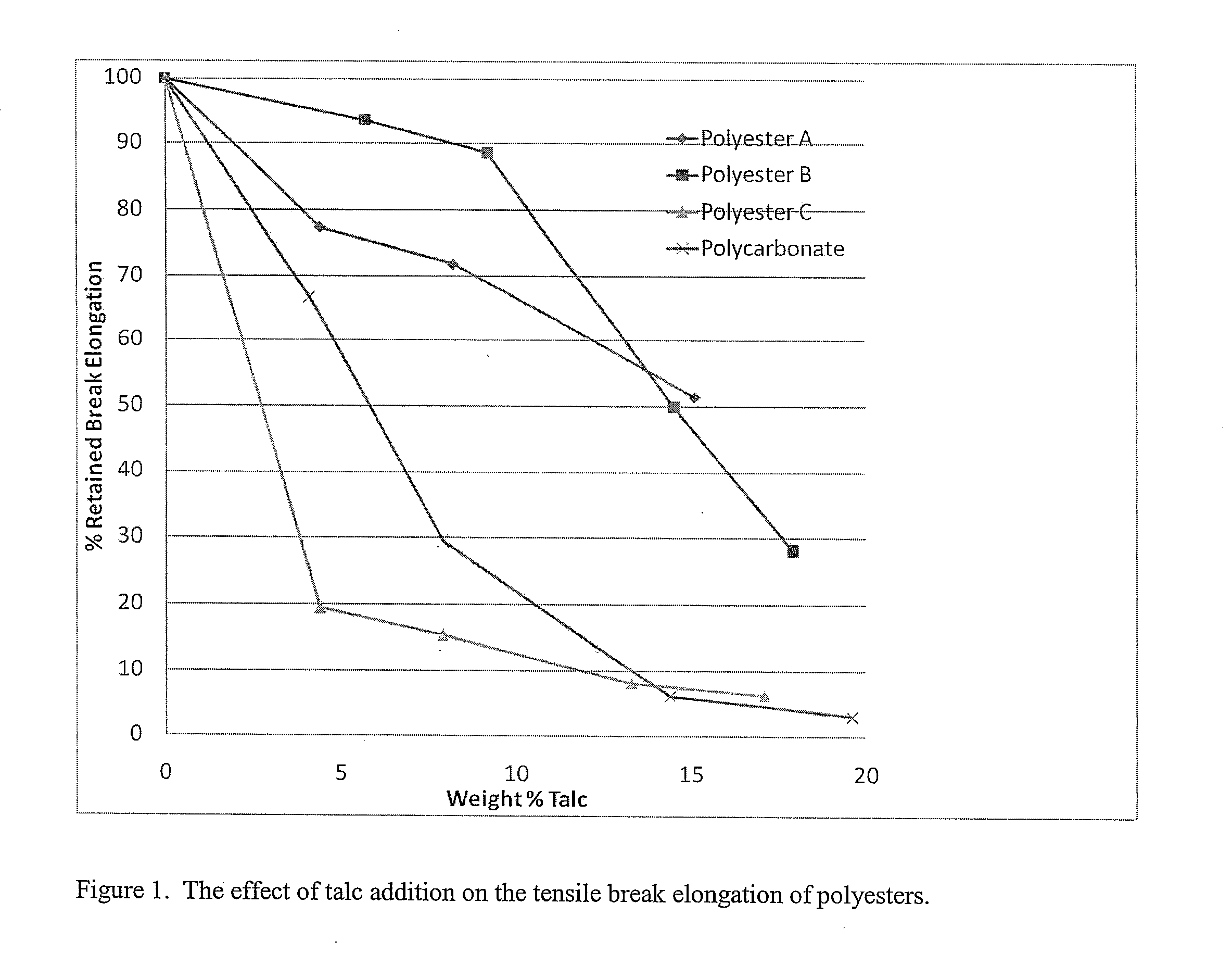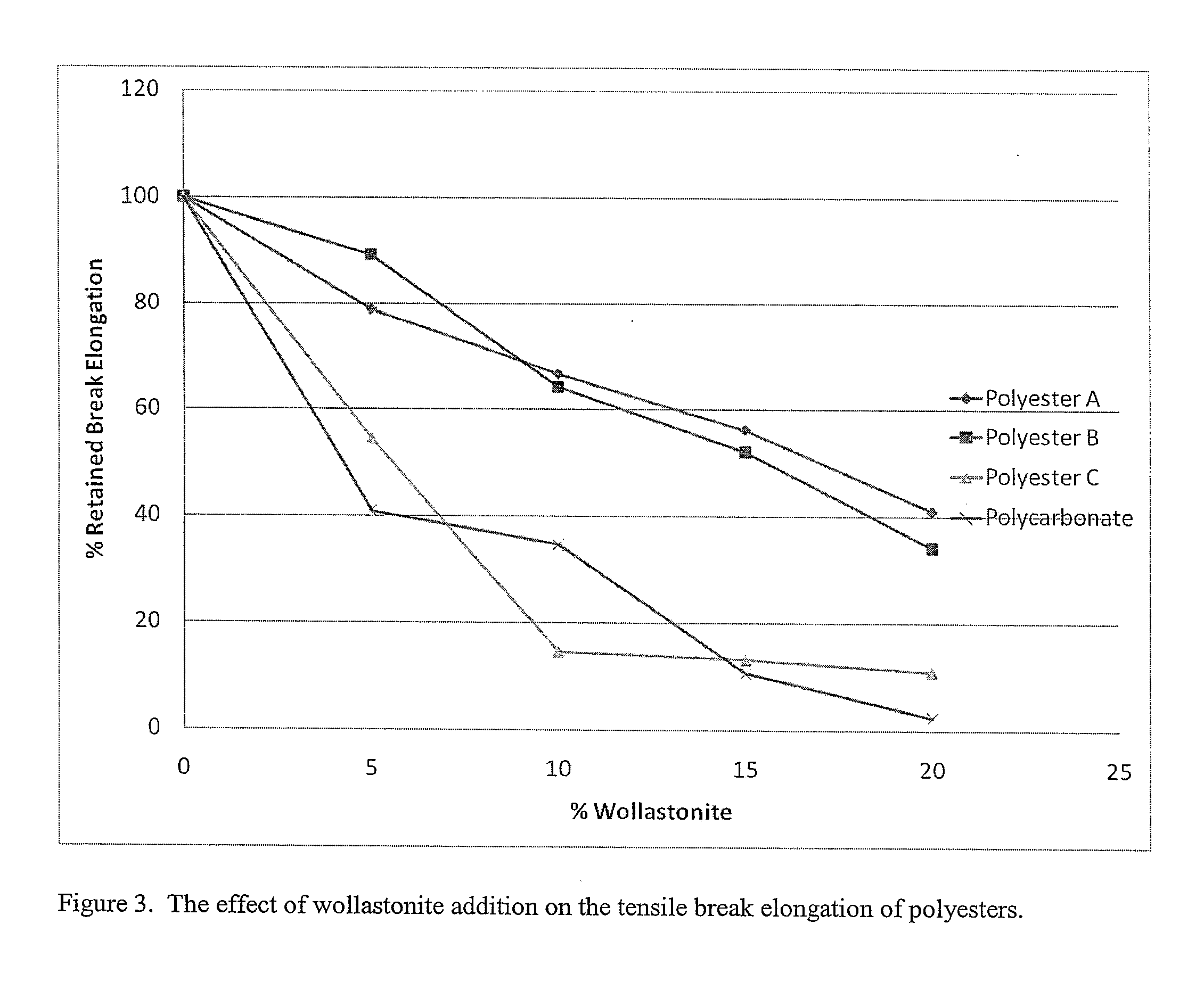Reinforced polyester compositions having improved toughness
a technology of reinforced polyester and composition, applied in the field of polymer composition, can solve the problems of significant decrease in the toughness of the polymer formulation, loss of toughness, and reduction of properties such as impact strength and tensile elongation at break
- Summary
- Abstract
- Description
- Claims
- Application Information
AI Technical Summary
Benefits of technology
Problems solved by technology
Method used
Image
Examples
example 1
Counter Example 1
[0093]The aliphatic-aromatic polyester (Polyester C) used was EastarCopolyester 6763. It contained terephthalic acid and approximately 3 μmol % cyclohexanedimethanol and 69 mol % ethylene glycol. Its inherent viscosity was 0.73. The mineral filler used was an untreated talc with an average particle size of 7 microns.
[0094]The aliphatic-aromatic polyester was dried at 70° C. and the talc was not dried. Formulations were prepared in a 40 mm Werner-Pflieder twin screw extruder. The polyester and talc were fed into the extruder by separate gravimetric feeders and the extruded strand was pelletized. The pellets were injection molded into parts on a Toyo 90 injection molding machine. The extruder was run at 300 rpm at a total feed rate of 180 pounds / hr. Processing temperatures used were in the range of 260° C. to 280° C. The compositions and properties of the blends are shown in Table 5. The weight percent of talc was calculated by measuring the weight percent ash level i...
example 2
Counter Example 2
[0095]The aliphatic-aromatic polyester (Polyester C) used was Eastar Copolyester 6763. It contained terephthalic acid and approximately 31 mol % cyclohexanedimethanol and 69 mol % ethylene glycol. Its inherent viscosity was 0.73. The mineral filler used was an untreated calcium carbonate with an average particle size of 1 micron.
[0096]The aliphatic-aromatic polyester was dried at 70° C. and the calcium carbonate was not dried. Formulations were prepared in a 40 mm Werner-Pflieder twin screw extruder. The polyester and calcium carbonate were fed into the extruder by separate gravimetric feeders and the extruded strand was pelletized. The pellets were injection molded into parts on a Toyo 90 injection molding machine. The extruder was run at 300 rpm at a total feed rate of 180 pounds / hr. Processing temperatures used were in the range of 260° C. to 280° C. The compositions and properties of the blends are shown in Table 6. The weight percent of calcium carbonate was ca...
example 3
Counter Example 3
[0097]The polyester used was the polycarbonate of 4,4′-isopropylidenediphenol (bisphenol A). The mineral filler used was an untreated talc with an average particle size of 7 microns.
[0098]The polycarbonate polyester was dried at 90° C. and the talc was not dried. Formulations were prepared in a 40 mm Werner-Pflieder twin screw extruder. The polyester and talc were fed into the extruder by separate gravimetric feeders and the extruded strand was pelletized. The pellets were injection molded into parts on a Toyo 90 injection molding machine. The extruder was run at 300 rpm at a total feed rate of 180 pounds / hr. Processing temperatures used were in the range of 270° C. to 290° C. The compositions and properties of the blends are shown in Table 7. The weight percent of talc was calculated by measuring the weight percent ash level in the sample. The sample containing no filler was not extruded; typical properties after injection molding are shown for it.
TABLE 7UNITS% Pol...
PUM
| Property | Measurement | Unit |
|---|---|---|
| heat distortion temperature | aaaaa | aaaaa |
| wt % | aaaaa | aaaaa |
| mol % | aaaaa | aaaaa |
Abstract
Description
Claims
Application Information
 Login to View More
Login to View More - R&D
- Intellectual Property
- Life Sciences
- Materials
- Tech Scout
- Unparalleled Data Quality
- Higher Quality Content
- 60% Fewer Hallucinations
Browse by: Latest US Patents, China's latest patents, Technical Efficacy Thesaurus, Application Domain, Technology Topic, Popular Technical Reports.
© 2025 PatSnap. All rights reserved.Legal|Privacy policy|Modern Slavery Act Transparency Statement|Sitemap|About US| Contact US: help@patsnap.com



